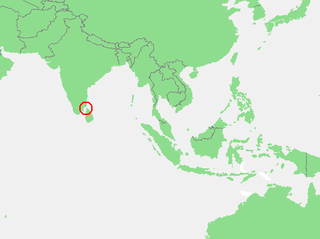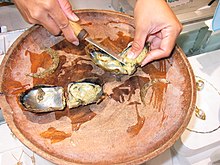
A pearl is a hard, glistening object produced within the soft tissue of a living shelled mollusk or another animal, such as fossil conulariids. Just like the shell of a mollusk, a pearl is composed of calcium carbonate in minute crystalline form, which has deposited in concentric layers. The ideal pearl is perfectly round and smooth, but many other shapes, known as baroque pearls, can occur. The finest quality of natural pearls have been highly valued as gemstones and objects of beauty for many centuries. Because of this, pearl has become a metaphor for something rare, fine, admirable and valuable.

The Gulf of Mannar is a large shallow bay forming part of the Laccadive Sea in the Indian Ocean with an average depth of 5.8 m (19 ft). It lies between the southeastern tip of India and the west coast of Sri Lanka, in the Coromandel Coast region. The chain of low islands and reefs known as Adam’s Bridge or Rama Setu, which includes Mannar Island, separates the Gulf of Mannar from Palk Bay, which lies to the north between India and Sri Lanka. The estuaries of Thamirabarani River and Vaippar River of South India and the Malvathu Oya of Sri Lanka drain into the Gulf. The dugong is found here.

Baroque pearls are pearls with an irregular, non-spherical shape. Shapes can range from minor aberrations to distinctly ovoid, curved, pinched, or lumpy shapes. Most cultured freshwater pearls are baroque because freshwater pearls are mantle-tissue nucleated instead of bead nucleated. Cultured saltwater pearls can also be baroque, but tend to be more teardrop-shaped due to the use of a spherical nucleation bead.

Cultured pearls are pearls which are formed within a cultured pearl sac with human intervention in the interior of productive living molluscs in a variety of conditions depending upon the mollusc and the goals. Having the same material as natural pearls, cultured pearls can be cultivated in seawater or freshwater bodies. Over 95% of the pearls available on the market are cultured pearls.

Rangiroa or Te Kokōta is the largest atoll in the Tuamotus and one of the largest in the world.

The Laccadive Sea, also known as the Lakshadweep Sea, is a body of water bordering India, the Maldives, and Sri Lanka. It is located to the southwest of Karnataka, to the west of Kerala and to the south of Tamil Nadu. This warm sea has a stable water temperature through the year and is rich in marine life, the Gulf of Mannar alone hosting about 3,600 species. Mangaluru, Kasaragod, Kannur, Kozhikode, Ponnani, Kochi, Alappuzha, Kollam, Thiruvananthapuram, Tuticorin, Colombo, and Malé are the major cities on the shore of the Laccadive Sea. Kanyakumari, the southernmost tip of peninsular India, also borders this sea.

The freshwater pearl mussel is an endangered species of freshwater mussel, an aquatic bivalve mollusc in the family Margaritiferidae.

Dosinia is a genus of saltwater clams, marine bivalve molluscs in the family Veneridae, subfamily Dosiniinae Deshayes, 1853. The shell of Dosinia species is disc-like in shape, usually white, and therefore is reminiscent of the shells of Lucinid bivalves.

Pinctada albina is a species of pearl oyster of the genus Pinctada, known as the Shark Bay shell. Another common name is the Arafura shell, endemic to Arafura Sea in Indonesia. It is called the "Amami gai" in Japan.
P. imbricata may refer to:

The Tahitian pearl is an organic gem formed from the black lip oyster. These pearls derive their name from the fact that they are primarily cultivated around the islands of French Polynesia, around Tahiti.

Linatella caudata, common name : the Girdled triton or Poulsen's Triton, is a species of predatory sea snail, a marine gastropod mollusk in the family Cymatiidae.

Pinctada maxima is a species of pearl oyster, a marine bivalve mollusk in the family Pteriidae, the pearl oysters. There are two different color varieties: the Gold-lipped oyster and the Silver-lipped oyster. These bivalves are the largest pearl oysters in the world. They have a very strong inner shell layer composed of nacre, also known as "mother of pearl" and are important to the cultured pearl industry as they are cultivated to produce South Sea pearls.

Pinctada radiata, commonly known as the Atlantic pearl-oyster or the Gulf pearl oyster is a species of pearl oyster distributed throughout the Indo-Pacific and in the Mediterranean. Its range extends as far north as Japan and as far south as the Australian state of Victoria.
Heterocapsa circularisquama is a species of dinoflagellate notable for the production of a biotoxin affecting marine fauna. It is known to produce large red tides off western Japan, causing high bivalve mortality, particularly pearl oysters. It is very similar to Heterocapsa illdefina, however H. circularisquama carries six radiating ridges on its circular basal plate, and its scales have longer spines, among other subtle differences in morphology.

Pinctada mazatlanica is a species of tropical marine bivalve mollusc in the family Pteriidae, the pearl oysters. It is known by the English common names pearl oyster, Mazatlan pearl oyster, and Panama pearl oyster. Spanish common names include madre perla, and ostra perlifera panameña. This mollusc was first described to science in 1856 by conchologist Sylvannus Charles Thorp Hanley. Pinctada mazatlanica produces gem-quality pearls and was the basis of a pearling industry in the Gulf of California for centuries.
Pinctada fucata, the Akoya pearl oyster (阿古屋貝), is a species of marine bivalve mollusk in the family Pteriidae, the pearl oysters. Some authorities classify this oyster as Pinctada fucata martensii. It is native to shallow waters in the Indo-Pacific region and is used in the culture of pearls.

Pinctada margaritifera, commonly known as the black-lip pearl oyster, is a species of pearl oyster, a saltwater mollusk, a marine bivalve mollusk in the family Pteriidae. This species is common in the Indo-Pacific within tropical coral reefs.
Pinctada longisquamosa, sometimes called scaly pearl osters, are a small species of pearl oyster found in the western Atlantic. They are distinguished by unique prismatic shell structures which protrude from the outer shell.

















